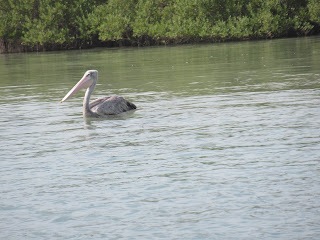Farasan Islands
We took the free ferry from Jazan to the Farasan Islands, an archaepeligo of coral islands in the Red Sea. We were up to get the truck to take us to the port for an early ferry. We were segregated with women going through one passport and security check and men through another. On the far side, the waiting areas were segregated. All the local women wore black with their hair covered and a veil so only their eyes showed. The giels in our group worelong sleeves and covered their legs but they stood out in colourful clothing and no headgear.
We boarded the ferry for the one and a quarter journey to the islands. The ferry was also segregated with women at the front and men at the back except for one aft corner that was for families. Any man sitting in the women's section was asked to move and the girls that sat with the men were also asked to move.
We reached the Farasan Island port and disembarked. The islands are all made of coral rock and are just a few metres above sea level. We were met by our local guide who was goig to show us the island. As we left the port, there were signs warning drivers about gazelles crossing the road. We looked hard but saw none.
First stop was a maritime museum, although it was a rebuilt local fishing village made from local coral rock. There were no signs or information boards...you made the narrative up yourself. It wasn't difficult as we had been to deveral villages now. Our guide had to be cajouled into telling us more. He was from this village although no one lives there now. People used to live here for the three hot summer months for fishing before returning to the mainland.The village was paved and the walls still stood or had been rebuilt but none of the buildings had a roof.
A view down one of the side streets.
Then we were taken to the beach for a swim. It was a public beach and empty of people. The sand had a lot of bird foorprints as if it had been very busy earlier but except for a pair of black headed larks, it was deserted. The beach was also beautifully clean with no litter and very little dead twigs and seaweed at the high water mark.
A view of the beach and the flimsey little shelter that provided shade.
Some of the flora along the beach.
Then we headed to the harbour to have a speed boat ride to an interesting coastal conservation area but not part of the Marine Sanctuary at the far end of the main island.
...some bouys marking some shallows...
...some sea birds...
...one of many islands...
...and another......some floating rocks...
...a seabird that came to investigate us....
...more rocky outcrops...
...some mangrove swamps...
...and dozens of birds, but often too far away to easily identify but the two birders in our group gave a running commentary on the bird like around us. It wasn't just birds as we also saw fish, a turtle and a ray in the shallow waters of the mangroves.
After lunch on board and seeing loads of wildlife, we disembarked. We now had a whirlwind tour of the town to get back to the ferry for the afternoon sailing.
The Ottoman Fort which dates from the 14th century but this rebuilt fort is more modern built to keep an eye on the locals and to garrison the islands which stand near the mouth of the Red Sea and the Gulf of Aden.
We had a stop at the old mosque but it was closed although we did see the entrance with some delicately carved coral rock...
...and the mass of carving on one of the walls of the mosque that peaked above the perimeter wall around the site.
And an old building that has yet to have the magic wand waved at it to 'preserve' it (read rebuilt)...
...and the ornate entrance to a pearl merchants house for which the area was famous as a major source of pearls until much cheaper cultivated pearls swamped the market and the natural pearl fisheries were unable to compete and so closed.
Another ornately carved wall of the merchant's house...
...and some detail of the inside decoration.
The modern mosque...
...and after a ferry ride back to the mainland at Jazan, a walk along the corniche, recently upgraded with a new park beside it and colourfully lit at night.

























No comments:
Post a Comment